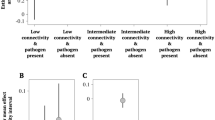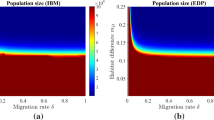Abstract
Observational evidence is scarce concerning the distribution of plant pathogen population sizes or densities as a function of time-scale or spatial scale. For wild pathosystems we can only get indirect evidence from evolutionary patterns and the consequences of biological invasions. We have little or no evidence bearing on extermination of hosts by pathogens, or successful escape of a host from a pathogen. Evidence over the last couple of centuries from crops suggest that the abundance of particular pathogens in the spectrum affecting a given host can vary hugely on decadal time-scales. However, this may be an artefact of domestication and intensive cultivation. Host-pathogen dynamics can be formulated mathematically fairly easily–for example as SIR-type differential equation or difference equation models, and this has been the (successful) focus of recent work in crops. “Long-term” is then discussed in terms of the time taken to relax from a perturbation to the asymptotic state. However, both host and pathogen dynamics are driven by environmental factors as well as their mutual interactions, and both host and pathogen co-evolve, and evolve in response to external factors. We have virtually no information about the importance and natural role of higher trophic levels (hyperpathogens) and competitors, but they could also induce long-scale fluctuations in the abundance of pathogens on particular hosts. In wild pathosystems the host distribution cannot be modelled as either a uniform density or even a uniform distribution of fields (which could then be treated as individuals). Patterns of short-term density-dependence and the detail of host distribution are therefore critical to long-term dynamics. Host density distributions are not usually scale-free, but are rarely uniform or clearly structured on a single scale. In a (multiply structured) metapopulation with co-evolution and external disturbances it could well be the case that the time required to attain equilibrium (if it exists) based on conditions stable over a specified time-scale is longer than that time-scale. Alternatively, local equilibria may be reached fairly rapidly following perturbations but the meta-population equilibrium be attained very slowly. In either case, meta-stability on various time-scales is a more relevant than equilibrium concepts in explaining observed patterns.





Similar content being viewed by others
References
Anon. (1890). The potato blight in Ireland: A plain statement of facts collected from various independent authorities. Dublin and London: The Irish Loyal and Patriotic Union.
Augspurger, C. (1983). Seed dispersal of the tropical tree Platypodium elegans and the escape of its seedlings from fungal pathogens. Journal of Ecology, 71, 759–771.
Bearchell, S. J., Fraaije, B. A., Shaw, M. W., & Fitt, B. D. L. (2005). Wheat archive links long-term fungal pathogen population dynamics to air pollution. Proceedings of the National Academy of Sciences of the United States of America, 102, 5438–5442.
Begon, M., Mortimer, M., & Thompson, D. J. (1996). Population ecology: A unified study of animals and plants (3rd ed.). Oxford: Blackwell.
Bennett, K. D., & Parducci, L. (2006). DNA from pollen: principles and potential. The Holocene, 16, 1031–1034.
Berbee, M. L., & Taylor, J. W. (2007). Rhynie chert: a window into a lost world of complex plant-fungus interactions. New Phytologist, 174, 475–479.
Bernasconi, G., Antonovics, J., Biere, A., Charlesworth, D., Delph, L. F., Filatov, D., et al. (2009). Silene as a model system in ecology and evolution. Heredity, 103, 5–14.
Brasier, C. M. (1990). The unexpected element: Mycovirus involvement in the outcome of two recent pandemics, Dutch elm disease and chestnut blight. In J. J. Burdon & S. R. Leather (Eds.), Pests, pathogens and plant communities (pp. 289–307). Oxford: Blackwell.
Brasier, C. M., & Buck, K. W. (2001). Rapid evolutionary changes in a globally invading fungal pathogen (Dutch elm disease). Biological Invasions, 3, 223–233.
Brasier, C. M., & Webber, J. F. (2010). Sudden larch death. Nature, 466, 824–825.
Bull, J. C., Kenyon, E. J., & Cook, K. J. (2012). Wasting disease regulates long-term population dynamics in a threatened seagrass. Oecologia, 169, 135–142.
Burdon, J. J., & Thrall, P. H. (1999). Spatial and temporal patterns in coevolving plant and pathogen associations. American Naturalist, 153 Supplement, S15–S33.
Burdon, J. J., & Thrall, P. H. (2009). Coevolution of plants and their pathogens in natural habitats. Science, 324, 755–756.
Camacho, J. P. M., Shaw, M. W., López-León, M. D., Pardo, M. C., & Cabrero, J. (1997). Population dynamics of a selfish B chromosome neutralized by the standard genome in the grasshopper Eyprepocnemis plorans. American Naturalist, 149, 1030–1050.
Carlsson-Graner, U., & Thrall, P. H. (2002). The spatial distribution of plant populations, disease dynamics and evolution of resistance. Oikos, 97, 97–110.
Chandramohan, P., & Shaw, M. W. (2013). Sulphate and sulphurous acid alter the relative susceptibility of wheat to Phaeosphaeria nodorum and Mycosphaerella graminicola. Plant Pathology. doi:10.1111/ppa.12052.
Cunniffe, N. J., & Gilligan, C. A. (2010). Invasion, persistence and control in epidemic models for plant pathogens: the effect of host demography. Journal of the Royal Society Interface, 7, 439–451.
Currah, R. S., & Stockey, R. A. (1991). A fossil smut fungus from the anthers of an Eocene angiosperm. Nature, 350, 698–699.
Dieguez, C., & Lopez-Gomez, J. (2005). Fungus-plant interaction in a Thuringian (Late permian) Dadoxylon sp. in the SE Iberian Ranges, eastern Spain. Palaeogeography Palaeoclimatology Palaeoecology, 229, 69–82.
Ellis, M. B., & Ellis, J. P. (1997). Microfungi on land plants: An identification handbook, New enlarged edn. Richmond Publishing, Slough, UK.
Eriksen, L., Shaw, M. W., & Østergård, H. (2001). A model of the effect of pseudothecia on genetic recombination and epidemic development in populations of Mycosphaerella graminicola. Phytopathology, 91, 240–248.
Evans, H. C. (2008). The endophyte-enemy release hypothesis: Implications for classical biological control and plant invasions. In: XII International Symposium on Biological Control of Weeds (pp. 20–25). La Grande Motte, France.
Field, S. G., Schoettle, A. W., Klutsch, J. G., Tavener, S. J., & Antolin, M. F. (2012). Demographic projection of high-elevation white pines infected with white pine blister rust: a nonlinear disease model. Ecological Applications, 22, 166–183.
Friesen, T. L., Stukenbrock, E. H., Liu, Z. H., Meinhardt, S., Ling, H., Faris, J. D., et al. (2006). Emergence of a new disease as a result of interspecific virulence gene transfer. Nature Genetics, 38, 953–956.
Gagic, V., Tscharntke, T., Dormann, C. F., Gruber, B., Wilstermann, A., & Thies, C. (2011). Food web structure and biocontrol in a four-trophic level system across a landscape complexity gradient. Proceedings of the Royal Society B: Biological Sciences, 278, 2946–2953.
Innes, J., Blackford, J., & Chambers, F. (2006). Kretzschmaria deusta and the northwest European mid-Holocene Ulmus decline at Moel y Gerddi, north Wales, United Kingdom. Palynology, 30, 121–132.
Jalas, J., & Suominen, J. (eds.) (1986). Atlas florae europaeae: Distribution of vascular plants in Europe. Vol. 7 Caryophyllaceae (Silenoideae).
James, T. Y., Kauff, F., Schoch, C. L., Matheny, P. B., Hofstetter, V., Cox, C. J., et al. (2006). Reconstructing the early evolution of fungi using a six-gene phylogeny. Nature, 443, 818–822.
Jeger, M. J., Salama, N., Shaw, M. W., van den Berg, F., & van den Bosch, F. (2013). Effects of plant pathogens on population dynamics and community composition in grassland ecosystems: two case studies. European Journal of Plant Pathology. doi:10.1007/s10658-013-0325-1.
King, J. E. (1977). Surveys of diseases of winter wheat in England and Wales 1970–75. Plant Pathology, 26, 8–20.
Lovell, D. J., Hunter, T., Powers, S. J., Parker, S. R., & van den Bosch, F. (2004). Effect of temperature on latent period of septoria leaf blotch on winter wheat under outdoor conditions. Plant Pathology, 53, 170–181.
Madden, L., Hughes, G., & van den Bosch, F. (2007). The study of plant disease epidemics. St. Paul: APS Press.
Meentemeyer, R. K., Rank, N. E., Shoemaker, D. A., Oneal, C. B., Wickland, A. C., Frangioso, K. M., et al. (2008). Impact of sudden oak death on tree mortality in the Big Sur ecoregion of California. Biological Invasions, 10, 1243–1255.
Mougou, A., Dutech, C., & Desprez-Loustau, M.-L. (2008). New insights into the identity and origin of the causal agent of oak powdery mildew in Europe. Forest Pathology, 38, 275–287.
Newcombe, G., & Dugan, F. M. (2010). Fungal pathogens of plants in the homogocene. In Y. Gherbawy & K. Voigt (Eds.), Molecular identification of fungi. Berlin: Springer.
Packer, A., & Clay, K. (2004). Development of negative feedback during successive growth cycles of black cherry. Proceedings of the Royal Society B, 271, 317–324.
Paveley, N., Blake, J., Gladders, P., Cockerell, V., Oxley, S., Gosling, P., et al. (2013). HGCA wheat disease management guide. Stoneleigh Park: Agriculture and Horticulture Development Board.
Peters, J. C. (1994). Pattern and impact of disease in natural plant communities of different age. PhD thesis, Reading.
Peters, J. C., & Shaw, M. W. (1996). Effect of artificial exclusion and augmentation of fungal plant pathogens on a regenerating grassland. New Phytologist, 134, 295–307.
Preston, C. D., Pearman, D. A., & Dines, T. D. (2002). New Atlas of the British and Irish Flora. Oxford: Oxford University Press.
Roy, B. A., Coulson, T., Blaser, W., Policha, T., Stewart, J. L., Blaisdell, G. K., et al. (2011). Population regulation by enemies of the grass Brachypodium sylvaticum: demography in native and invaded ranges. Ecology, 92, 665–675.
Scherm, H., Ngugi, H. K., & Ojiambo, P. S. (2006). Trends in theoretical plant epidemiology. European Journal of Plant Pathology, 115, 61–73.
Shaw, M. W. (1994). Seasonally induced chaotic dynamics and their implications in models of plant disease. Plant Pathology, 43, 790–801.
Shaw, M. W. (2011). ….two blighted ears of wheat, which few persons would have thought it worthwhile to carry with them round the world…. The Microbiologist, 12, 36–39.
Shaw, M. W. (2014). Chaotic dynamics of pathosystems. In K. L. Stevenson & M. J. Jeger (Eds.), Exercises in plant disease epidemiology (2nd ed.). St. Paul: APS Press.
Shaw, M. W., & Peters, J. C. (1994). The biological environment and pathogen population dynamics: Uncertainty, coexistence and competition. In P. Blakeman & B. Williamson (Eds.), The ecology of plant pathogens (pp. 17–37). Wallingford: CABI.
Shaw, M. W., Bearchell, S. J., Fitt, B. D. L., & Fraaije, B. A. (2008). Long-term relationships between environment and abundance in wheat of Phaeosphaeria nodorum and Mycosphaerella graminicola. New Phytologist, 177, 229–238.
Stukenbrock, E. H., & McDonald, B. A. (2008). The origins of plant pathogens in agro-ecosystems. Annual Review of Phytopathology, 46, 75–100.
Tomley, A. J., & Evans, H. C. (2004). Establishment of, and preliminary impact studies on, the rust, Maravalia cryptostegiae, of the invasive alien weed, Cryptostegia grandiflora in Queensland, Australia. Plant Pathology, 53, 475–484.
van den Berg, F., & van den Bosch, F. (2004). A model for the evolution of pathogen-induced leaf shedding. Oikos, 107, 36–49.
van den Berg, F., van den Bosch, F., Powers, S. J., & Shaw, M. W. (2008). Apical leaf necrosis as a defence mechanism against pathogen attack: effects of high nutrient availability on onset and rate of necrosis. Plant Pathology, 57, 1009–1016.
Walters, D. R., Havis, N. D., & Oxley, S. J. P. (2008). Ramularia collo-cygni: the biology of an emerging pathogen of barley. FEMS Microbiology Letters, 279, 1–7.
Weir, A. H., Bragg, P. L., Porter, J. R., & Rayner, J. H. (1984). A winter wheat crop simulation model without water or nutrient limitations. Journal of Agricultural Science (Cambridge), 102, 371–382.
Xiaoqiang, L., Jie, Z., Ji, S., Chengyu, W., Hongli, Z., & Qianli, S. (2004). Vegetation history and climatic variations during the last 14 ka BP inferred from a pollen record at Daihai Lake, north-central China. Review of Paleobotany and Palynology, 132, 195–205.
Yoshida, K., Schuenemann, V. J., Cano, L. M., Pais, M., Mishra, B., Sharma, R., et al. (2013). The rise and fall of the Phytophthora infestans lineage that triggered the Irish potato famine. eLife, 2, e00731.
Zadoks, J. C. (1987). The function of plant pathogenic fungi in natural communities. Geobotany, 10, 201–207.
Zaffarano, P. L., McDonald, B. A., & Linde, C. C. (2008). Rapid speciation following recent host shifts in the plant pathogenic fungus Rhynchosporium. Evolution, 62, 1418–1436.
Author information
Authors and Affiliations
Corresponding author
Rights and permissions
About this article
Cite this article
Shaw, M.W. The population dynamics of disease on short and long time-scales. Eur J Plant Pathol 138, 487–497 (2014). https://doi.org/10.1007/s10658-013-0339-8
Accepted:
Published:
Issue Date:
DOI: https://doi.org/10.1007/s10658-013-0339-8




